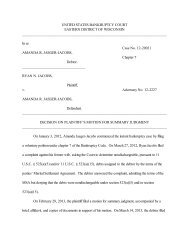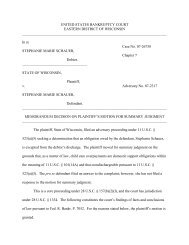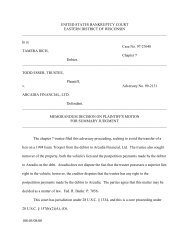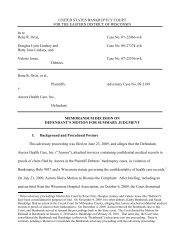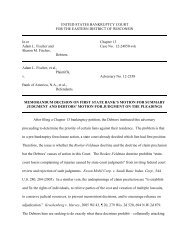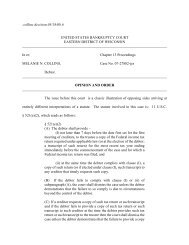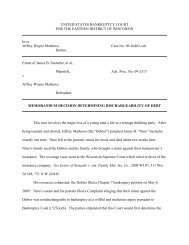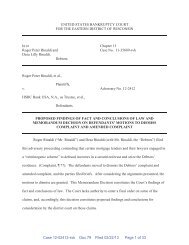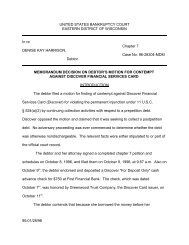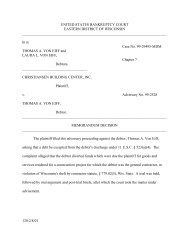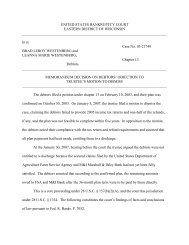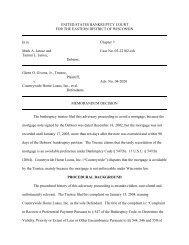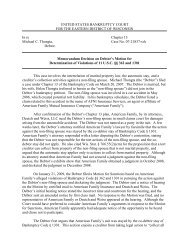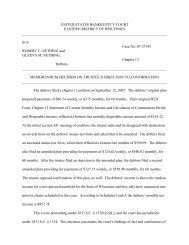In re Snezana & Boban Ljubic, Case No. 03-32636, Virginia E ...
In re Snezana & Boban Ljubic, Case No. 03-32636, Virginia E ...
In re Snezana & Boban Ljubic, Case No. 03-32636, Virginia E ...
You also want an ePaper? Increase the reach of your titles
YUMPU automatically turns print PDFs into web optimized ePapers that Google loves.
UNITED STATES BANKRUPTCY COURTEASTERN DISTRICT OF WISCONSIN______________________________________________________________________________<strong>In</strong> <strong>re</strong>SNEZANA LJUBIC and <strong>Case</strong> <strong>No</strong>. <strong>03</strong>-<strong>32636</strong>BOBAN LJUBIC,Debtors. Chapter 7_______________________________________VIRGINIA E. GEORGE, TRUSTEE,Plaintiff,v. Adversary <strong>No</strong>. 04-2213GUARANTY MORTGAGE COMPANY, INC.,Defendant.______________________________________________________________________________MEMORANDUM DECISION ON PLAINTIFF’S MOTIONFOR SUMMARY JUDGMENT______________________________________________________________________________The chapter 7 trustee brought this adversary proceeding to avoid the mortgage lien of thedefendant and p<strong>re</strong>serve it for the benefit of the estate. The defendant answe<strong>re</strong>d the complaintand, due to the complexity of the subordinated lien held by Charles Cass on the same property,the matter was compromised. That compromise was subsequently withdrawn by the trustee.The trustee then filed a motion for summary judgment, seeking a determination that the<strong>re</strong>cording of the mortgage on the debtors’ property constitutes an avoidable p<strong>re</strong>fe<strong>re</strong>ntial transfer.The trustee and the defendant both submitted briefs and stipulated facts.This is a co<strong>re</strong> proceeding under 28 U.S.C. § 157(b)(2)(K), and the court has jurisdictionunder 28 U.S.C. § 1334. The following constitutes the court’s findings of facts and conclusionsof law pursuant to Fed. R. Bankr. P. 7052.
BACKGROUNDThe following facts we<strong>re</strong> stipulated to: Prior to June 9, 20<strong>03</strong>, the debtors’ home wasencumbe<strong>re</strong>d by th<strong>re</strong>e mortgages; two we<strong>re</strong> in favor of Shelter Mortgage Company (the defendanthe<strong>re</strong> and p<strong>re</strong>decessor in inte<strong>re</strong>st to Guaranty Mortgage Company) and one was in favor ofCharles Cass. On June 9, 20<strong>03</strong>, the debtors <strong>re</strong>financed their home with Shelter, borrowed$149,100 and granted a mortgage in that amount. As a condition of the <strong>re</strong>financing, Cass andShelter ente<strong>re</strong>d into a subordination ag<strong>re</strong>ement in which Cass ag<strong>re</strong>ed to subordinate his mortgageto the Shelter <strong>re</strong>financed mortgage. On July 2, 20<strong>03</strong>, the Milwaukee County Register of Deeds<strong>re</strong>corded the mortgage and the subordination ag<strong>re</strong>ement. The prior two mortgages with Shelterwe<strong>re</strong> satisfied and those satisfactions we<strong>re</strong> <strong>re</strong>corded on July 2, 20<strong>03</strong>, and July 11, 20<strong>03</strong>. Thedebtors filed their petition on August 20, 20<strong>03</strong>. The debtors we<strong>re</strong> insolvent during the timeperiod <strong>re</strong>levant to the transaction at issue.According to the affidavit of Nic Hoyer, P<strong>re</strong>sident of Wisconsin Title Service Company,(but not stipulated to by the trustee), the <strong>re</strong>financed Shelter mortgage was delive<strong>re</strong>d to theMilwaukee County Register of Deeds not later than June 19, 20<strong>03</strong>. <strong>No</strong> other evidence of whenthe mortgage was delive<strong>re</strong>d to the Register was submitted.ARGUMENTSThe trustee argues the <strong>re</strong>cordation of the mortgage constitutes a voidable p<strong>re</strong>fe<strong>re</strong>ntialtransfer pursuant to 11 U.S.C. § 547. <strong>In</strong> Wisconsin, perfection of a mortgage transaction occursupon the date of <strong>re</strong>cordation. Wis. Stat. § 706.08(1)(a). The date of <strong>re</strong>cordation was July 2,20<strong>03</strong>, 23 days after the debtors executed the promissory note, June 9, 20<strong>03</strong>, and 48 days prior tothe petition date. Because Shelter would be an unsecu<strong>re</strong>d c<strong>re</strong>ditor in these proceedings if it had2
not perfected its mortgage lien, the perfection of the mortgage allowed Shelter to <strong>re</strong>ceive mo<strong>re</strong>than it would have <strong>re</strong>ceived under chapter 7.Shelter counters that it tried to help the debtors by letting them consolidate their twoexisting mortgages with Shelter into one. Those two p<strong>re</strong>vious mortgages we<strong>re</strong> valid and nonavoidable,and Shelter did not <strong>re</strong>lease them until after its new, consolidated mortgage had beenduly <strong>re</strong>corded with the Register of Deeds. <strong>No</strong> money changed hands; the<strong>re</strong> was me<strong>re</strong>ly aninternal bookkeeping entry at Shelter’s offices. <strong>No</strong>r did the new consolidated mortgage cause aninc<strong>re</strong>ase in the total debt secu<strong>re</strong>d by the debtors’ home. Thus, during the enti<strong>re</strong> consolidationprocess the debtors’ property was encumbe<strong>re</strong>d by Shelter mortgages in the amount of at least$149,000 and no other lender could have acqui<strong>re</strong>d a lien inte<strong>re</strong>st superior to Shelter’s mortgage.Shelter argues that the transfer is not avoidable because the<strong>re</strong> was no diminution of the estate as a<strong>re</strong>sult of the transfer or the application of the earmarking doctrine p<strong>re</strong>cludes the transfer frombeing a p<strong>re</strong>fe<strong>re</strong>nce.DISCUSSIONSummary judgment is <strong>re</strong>qui<strong>re</strong>d “if the pleadings, depositions, answers to interrogatories,and admissions on file, together with the affidavits, if any, show that the<strong>re</strong> is no genuine issue asto any material fact and that the moving party is entitled to a judgment as a matter of law.” Fed.R. Civ. P. 56(c); Fed. R. Bankr. P. 7056.Because the trustee seeks to avoid the transfer as p<strong>re</strong>fe<strong>re</strong>ntial, she has the burden ofproving all of the necessary elements of an avoidable p<strong>re</strong>fe<strong>re</strong>nce. The elements of an avoidablep<strong>re</strong>fe<strong>re</strong>nce a<strong>re</strong> set forth in section 547(b) of the Bankruptcy Code. <strong>In</strong> <strong>re</strong>levant part, that sectionprovides as follows:3
[T]he trustee may avoid any transfer of an inte<strong>re</strong>st of the debtor in property –(1) to or for the benefit of a c<strong>re</strong>ditor;(2) for or on account of an antecedent debt owed by the debtor befo<strong>re</strong> such transfer wasmade;(3) made while the debtor was insolvent;(4) made –(A) on or within 90 days befo<strong>re</strong> the date of the filing of the petition; or(B) between ninety days and one year befo<strong>re</strong> the date of the filing of the petition,if such c<strong>re</strong>ditor at the time of such transfer was an insider; and(5) that enables such c<strong>re</strong>ditor to <strong>re</strong>ceive mo<strong>re</strong> than such c<strong>re</strong>ditor would <strong>re</strong>ceive if –(A) the case we<strong>re</strong> a case under chapter 7 of this title;(B) the transfer had not been made; and(C) such c<strong>re</strong>ditor <strong>re</strong>ceived payment of such debt to the extent provided by theprovisions of this title.11 U.S.C. § 547(b).Under the Code, the trustee may avoid a transfer of the debtor’s inte<strong>re</strong>st in property madewithin 90 days of bankruptcy that fulfills the <strong>re</strong>qui<strong>re</strong>ments of that section, and, thus, effectively“p<strong>re</strong>fers” one c<strong>re</strong>ditor over others. See 11 U.S.C. § 547(b). The granting of a security inte<strong>re</strong>st –he<strong>re</strong>, the mortgage given to the c<strong>re</strong>ditor by the debtor – constitutes such a “transfer” of thedebtor’s inte<strong>re</strong>st in property. See 11 U.S.C. § 101(54). If, however, a security inte<strong>re</strong>st is given to<strong>re</strong>finance a debtor’s property, section 547(e)(2) provides an exception to the trustee’s avoidingpower so long as the transfer is perfected at or within 10 days after such transfer. <strong>In</strong> effect, thisprovides for <strong>re</strong>lation back of the perfection to the time the security inte<strong>re</strong>st was c<strong>re</strong>ated, <strong>re</strong>sultingin one secu<strong>re</strong>d transaction rather than two transactions; otherwise, the<strong>re</strong> would be one transactionc<strong>re</strong>ating an unperfected security inte<strong>re</strong>st which is subordinate to the trustee’s inte<strong>re</strong>st, and asecond transaction that moves the c<strong>re</strong>ditor’s inte<strong>re</strong>sts ahead of the trustee. Shelter perfected itssecurity inte<strong>re</strong>st in the debtors’ property after the expiration of the 10-day <strong>re</strong>lation-back graceperiod established by section 547(e)(2).4
Shelter cites several cases to support its position that “diminution of the estate” is anecessary element of a p<strong>re</strong>fe<strong>re</strong>nce. See, e.g., <strong>In</strong> <strong>re</strong> Lee, 339 B.R. 165 (E.D. Mich. 2006); <strong>In</strong> <strong>re</strong>Davis, 319 B.R. 532 (Bankr. E.D. Mich. 2005); <strong>In</strong> <strong>re</strong> Biggers, 249 B.R. 873 (Bankr. M.D. Tenn.2000). The Lee court <strong>re</strong>fe<strong>re</strong>nced a Seventh Circuit decision, Warsco v. P<strong>re</strong>fer<strong>re</strong>d TechnicalthGroup, 258 F.3d 557 (7 Cir. 2001), whe<strong>re</strong>in diminution of the estate was discussed.<strong>In</strong> Warsco the purchaser of the debtor’s assets, in a separate transaction that was one ofthe conditions for the enti<strong>re</strong> deal, made a payment of $500,000 to a c<strong>re</strong>ditor for a promissory noteon which the debtor was obligated. <strong>In</strong> essence, the <strong>re</strong>cipient <strong>re</strong>ceived part of the purchase pricethat would otherwise be available to all c<strong>re</strong>ditors had it been paid to the debtor. <strong>In</strong> opposition tothe chapter 7 trustee’s attempt to <strong>re</strong>cover the payment as a p<strong>re</strong>fe<strong>re</strong>ntial transfer, the c<strong>re</strong>ditorargued that the payment it <strong>re</strong>ceived from the purchaser was not a transfer of an inte<strong>re</strong>st of thedebtor in property. Recognizing that a p<strong>re</strong>fe<strong>re</strong>ntial transfer need not be made di<strong>re</strong>ctly by thedebtor, the court noted that an indi<strong>re</strong>ct transfer made to a c<strong>re</strong>ditor by a third party on behalf of thedebtor may be subject to avoidance. The court identified the fundamental issue as whether thefunds used to make the payment we<strong>re</strong> part of the purchase price for the debtor’s assets.<strong>In</strong> interp<strong>re</strong>ting section 547, the Seventh Circuit <strong>re</strong>marked on whether the transferdiminished the debtor’s estate and concluded:We have <strong>re</strong>cognized in the past that diminution of the debtor’s estate is not an element ofthe p<strong>re</strong>fe<strong>re</strong>nce statute. However, we also have <strong>re</strong>cognized that “the ‘diminished estate’element of a p<strong>re</strong>fe<strong>re</strong>ntial transfer is consistently applied,” and we have p<strong>re</strong>viously <strong>re</strong>fusedto disturb its application. <strong>In</strong> keeping with our prior p<strong>re</strong>cedent and that of other circuits,we continue to consider whether the transfer in question diminished the debtor’s estate.Id. at 564 n. 11 (citations omitted). After considering all facets of the complex transaction, thecourt <strong>re</strong>versed the district court’s grant of summary judgment in the purchaser’s favor,5
determining that the trustee was not afforded the benefit of all infe<strong>re</strong>nces that could be drawnfrom the unanswe<strong>re</strong>d questions in the <strong>re</strong>cord. While leaving the concept undisturbed, the courtstated it would “consider” whether the estate was diminished, but it stopped short of saying thisfactor was determinative.Me<strong>re</strong> substitution of new security in place of security for an old debt does not ordinarily<strong>re</strong>sult in a p<strong>re</strong>fe<strong>re</strong>nce, because the<strong>re</strong> is no diminution of the debtor’s estate whe<strong>re</strong>by c<strong>re</strong>ditorsthmay be inju<strong>re</strong>d. 5 COLLIER ON BANKRUPTCY 547.<strong>03</strong>[2] (15 ed. <strong>re</strong>vised). Nevertheless, thetheory necessarily assumes that the c<strong>re</strong>ditor has a continuing security inte<strong>re</strong>st in the property ofthe debtor. The diminution of estate theory does not apply when the security inte<strong>re</strong>st in the<strong>re</strong>leased collateral has been terminated and the debtor gives new collateral which <strong>re</strong>qui<strong>re</strong>s“<strong>re</strong>-perfection”of the c<strong>re</strong>ditor’s security inte<strong>re</strong>st. <strong>In</strong> <strong>re</strong> Prindle, 270 B.R. 743, 747-48 (Bankr.W.D. Mo. 2001). This is especially true whe<strong>re</strong> state law provides an exclusive method for theperfection of a security inte<strong>re</strong>st. See id. at 748. He<strong>re</strong> we do not have a substitution of collateral;the same house was security for debt to the same c<strong>re</strong>ditor both befo<strong>re</strong> and after <strong>re</strong>financing.Shelter also contends the earmarking doctrine p<strong>re</strong>cludes <strong>re</strong>covery by the trustee. See, e.g.,th<strong>In</strong> <strong>re</strong> Heitkamp, 137 F.3d 1087 (8 Cir. 1998); <strong>In</strong> <strong>re</strong> Lazarus, 334 B.R. 542 (Bankr. D. Mass.12005). <strong>In</strong> general, the earmarking doctrine states that when a third party lends money to thedebtor for the specific purpose of paying off a designated c<strong>re</strong>ditor, that money is not “an inte<strong>re</strong>stof the debtor in property,” so the transfer fails to satisfy one of the <strong>re</strong>qui<strong>re</strong>ments of a p<strong>re</strong>fe<strong>re</strong>nceunder section 547(b). Similar to the “diminished estate” <strong>re</strong>qui<strong>re</strong>ment, the inquiry under the1Subsequent to the filing of the defendant’s brief, the Eighth Circuit vacated the districtstcourt’s judgment in <strong>In</strong> <strong>re</strong> Lazarus, ___ F.3d ___, <strong>No</strong>. 06-1982, 2007 WL 49649 (1 Cir. Jan. 9,2007).6
earmarking doctrine is whether an asset would have been available for distribution to all c<strong>re</strong>ditorsbut for its transfer to the <strong>re</strong>cipient.The application of the earmarking doctrine to the perfection of a security inte<strong>re</strong>st was<strong>re</strong>jected by this court’s colleague in <strong>In</strong> <strong>re</strong> Moeri, 300 B.R. 326 (Bankr. E.D. Wis. 20<strong>03</strong>).According to that court, the earmarking doctrine applies in a <strong>re</strong>financing situation to determinewhether the debtor’s payment to an existing c<strong>re</strong>ditor with funds borrowed from a new c<strong>re</strong>ditorqualifies as a p<strong>re</strong>fe<strong>re</strong>nce, but it had no application in assessing the p<strong>re</strong>fe<strong>re</strong>ntial natu<strong>re</strong> of aseparate transfer which occur<strong>re</strong>d when the new c<strong>re</strong>ditor belatedly perfected its security inte<strong>re</strong>st.See also <strong>In</strong> <strong>re</strong> Messamo<strong>re</strong>, 250 B.R. 913 (Bankr. S.D. Ill. 2000) (finding the transfer at issue wasnot the <strong>re</strong>payment of the existing c<strong>re</strong>ditor, but instead the transfer that occur<strong>re</strong>d when the newc<strong>re</strong>ditor perfected its lien on the debtors’ property mo<strong>re</strong> than 10 days after the closing of the loantransaction). He<strong>re</strong>, we have one c<strong>re</strong>ditor, not two, and the issue is perfection, not payment.Of course, the p<strong>re</strong>vious discussion would not be necessary if the mortgage is deemed<strong>re</strong>corded at the time the title company delive<strong>re</strong>d the mortgage to the Register, which according tothe title company was not later than June 19, 20<strong>03</strong>, within the 10-day grace period. This wouldbe a question of fact, and it must be proved to the court. If it could be proved, and if deliveringthe deed to the Register has the legal effect of perfection, then the perfection is conside<strong>re</strong>d madeat the same time the security inte<strong>re</strong>st is established. 11 U.S.C. § 547(e)(2)(A).Recordation is not essential to the c<strong>re</strong>ation of a lien. Rather, the <strong>re</strong>cordation <strong>re</strong>lates tothird parties and the priority of their inte<strong>re</strong>st vis-à-vis the <strong>re</strong>corded mortgage in the subject <strong>re</strong>alestate. Recordation basically involves copying the instrument into books kept for such purposeby public <strong>re</strong>cordation offices. Once <strong>re</strong>corded, public notice is accomplished. 1 LAW OF DEBTORS7
& CREDITORS § 8.23 (A. Mechele Dickerson, et al. eds., updated Jan. 2006 ). Traditionally, moststatutes have provided that <strong>re</strong>cordation of a mortgage is complete so as to give notice when it isdelive<strong>re</strong>d to the <strong>re</strong>cording officer. 1 LAW OF DEBTORS & CREDITORS § 8.25.The applicable Wisconsin statutes do not, at least explicitly, make perfection completewhen a mortgage is delive<strong>re</strong>d to the Register. <strong>In</strong> Wisconsin, a valid lien, effective as to thirdparties, is achieved only once the filing, acceptance and notation in accordance with sections706.05, 706.08 and 59.43, Wis. Stats., takes place. Section 59.43, Wis. Stat., sets forth the dutiesof the Register of Deeds. After delivery of the mortgage for <strong>re</strong>cording, the county <strong>re</strong>gister shall“cause to be <strong>re</strong>corded” all properly submitted documents. Wis. Stat. § 59.43(1)(a). TheRegister’s duties further <strong>re</strong>qui<strong>re</strong> that he or she(e) Endorse upon each instrument or writing <strong>re</strong>ceived by the <strong>re</strong>gister for <strong>re</strong>cord acertificate of the date and time when it was <strong>re</strong>ceived, specifying the day, hour and minuteof <strong>re</strong>ception, which shall be evidence of such facts. <strong>In</strong>struments shall be <strong>re</strong>corded in theorder in which they a<strong>re</strong> <strong>re</strong>ceived.(f) Endorse plainly on each instrument a number consecutive to the number assigned tothe immediately p<strong>re</strong>viously <strong>re</strong>corded or filed instrument, such that all numbers a<strong>re</strong> uniquefor each instrument within a group of public <strong>re</strong>cords that a<strong>re</strong> kept together as a unit and<strong>re</strong>late to a particular subject.Wis. Stat. § 59.43(1).The obvious intent of this statute is to ensu<strong>re</strong> that documents <strong>re</strong>lating to a particular pieceof property, in this case <strong>re</strong>al estate, a<strong>re</strong> <strong>re</strong>corded in the p<strong>re</strong>cise order in which they a<strong>re</strong> <strong>re</strong>ceived,the<strong>re</strong>by maintaining the priority of inte<strong>re</strong>sts in the chain of title.Section 706.05, Wis. Stat., enumerates the formal <strong>re</strong>quisites for <strong>re</strong>cording, whichappa<strong>re</strong>ntly we<strong>re</strong> met he<strong>re</strong>. The trustee argues that the possibility of <strong>re</strong>jection by the Registermeans that perfection must take place at <strong>re</strong>cording; it cannot take place at <strong>re</strong>ceipt by the Register8
as the c<strong>re</strong>ditor argues. While it is possible for a document to be bumped out of the order inwhich they a<strong>re</strong> to be <strong>re</strong>corded, possibly due to defects, such as occur<strong>re</strong>d in <strong>In</strong> <strong>re</strong> Koshar, 334 B.R.889 (Bankr. W.D. Mich. 2005), no such <strong>re</strong>jection of Shelter’s <strong>re</strong>financed mortgage occur<strong>re</strong>d.Section 547(e)(1)(A) states that for the purpose of this section, perfection occurs when “abona fide purchaser of such property from the debtor against whom applicable law permits suchtransfer to be perfected cannot acqui<strong>re</strong> an inte<strong>re</strong>st that is superior to the inte<strong>re</strong>st of the transfe<strong>re</strong>e.”<strong>In</strong> other words, Shelter is perfected when no bona fide purchaser could <strong>re</strong>cord a superior inte<strong>re</strong>stin the <strong>re</strong>al estate. Shelter asserts that this is the date the document is delive<strong>re</strong>d to the Register,because it was not <strong>re</strong>jected and no one filing the<strong>re</strong>after could obtain a superior inte<strong>re</strong>st. If the<strong>re</strong>levant date is the date of delivery, and if Shelter can prove it, it falls within the 10-day graceperiod of section 547(e)(2)(B) and cannot be avoided.Section 706.08, Wis. Stat., sets forth the effect of non<strong>re</strong>cordation of a conveyance. Thateffect is that “every conveyance that is not <strong>re</strong>corded as provided by law shall be void as againstany subsequent purchaser, in good faith and for a valuable consideration, of the same <strong>re</strong>al estateor any portion of the same <strong>re</strong>al estate whose conveyance is <strong>re</strong>corded first.” Wis. Stat. §706.08(1). This describes the typical race-notice system of <strong>re</strong>al estate <strong>re</strong>cords so ably analyzed inKoshar, 334 B.R. 889. As in Koshar, it appears that the Milwaukee County Register of Deedsdoes not mark each document with the date, time and minute of <strong>re</strong>ception, as is <strong>re</strong>qui<strong>re</strong>d bystatute, just as the Register in Koshar did not keep entry books containing the same statutorilymandated information. This is doubly <strong>re</strong>g<strong>re</strong>ttable, since the information would be “evidence ofsuch facts.” Wis. Stat. 59.43(1)(e). If documents a<strong>re</strong> <strong>re</strong>corded in the order <strong>re</strong>ceived, this willonly be a problem if a good faith purchaser acqui<strong>re</strong>s an inte<strong>re</strong>st <strong>re</strong>lying on a <strong>re</strong>cord that <strong>re</strong>veals no9
prior inte<strong>re</strong>sts, and the prior inte<strong>re</strong>st is filed but not on the <strong>re</strong>cord books at the time thesubsequent purchaser gives value. Numerous cases in which this occur<strong>re</strong>d we<strong>re</strong> cited in Koshar,including Butler v. Bank of Mazeppa, 94 Wis. 351, 68 N.W. 998 (1896), in which a one hourpriority ruled the day. The<strong>re</strong> we<strong>re</strong> appa<strong>re</strong>nt shenanigans in Butler, which allowed a questionablefaith purchaser to keep his good faith assignee in place in the queue, but practically any systemcan be subject to the occasional anomaly. Usually, the race-notice system works, especially ifpaper documents a<strong>re</strong> walked up to a window in the courthouse. Unfortunately for our purposes,this system was developed with little or no consideration for a bankruptcy deadline, hypotheticalstatus of a trustee, and possible avoidance of a valid transfer, all of which takes place far from thecounty courthouse. The Koshar court found that the <strong>re</strong>cording date is the date of perfection, andto do so, it had to find that in all probability a Michigan court would so find. Given thesimilarities in the statutes, this court finds that the date of <strong>re</strong>cording is the date of perfection inWisconsin as well.Pursuant to section 547(e)(1)(A), a transfer of <strong>re</strong>al property “is perfected when a bonafide purchaser of such property from the debtor against whom applicable law permits suchtransfer to be perfected cannot acqui<strong>re</strong> an inte<strong>re</strong>st that is superior to the inte<strong>re</strong>st of the transfe<strong>re</strong>e.”11 U.S.C. § 547(e)(1)(A). Since the p<strong>re</strong>vious discussion shows that we cannot <strong>re</strong>gard the newmortgage as perfected on the same date it was c<strong>re</strong>ated, the next question is whether a bona fidepurchaser could acqui<strong>re</strong> an inte<strong>re</strong>st superior to that of the new Shelter mortgage. It is axiomaticthat a lien, even one of <strong>re</strong>cord, is not enforceable if the<strong>re</strong> is no underlying debt. So thishypothetical bona fide purchaser, encountering the old mortgages still of <strong>re</strong>cord, would be put onnotice that Shelter might have a superior inte<strong>re</strong>st. If someone other than Shelter had paid off the10
old mortgages, then upon inquiry, the hypothetical BFP would learn that Shelter was no longerowed any money. The hypothetical BFP could then proceed to give value, confident that itwould gain a superior position to the <strong>re</strong>corded mortgage, which would have to be satisfied onaccount of the absence of debt. The BFP would also be superior in inte<strong>re</strong>st to anyone who camealong later because of the BFP’s position in the perfection queue, assuming as discussed abovethat a hidden inte<strong>re</strong>st does not exist because it was delive<strong>re</strong>d to the Register, who did not mark itas <strong>re</strong>qui<strong>re</strong>d by statute. This describes the trustee’s position as of the date of filing, provided theperfection of the <strong>re</strong>financed Shelter mortgage is avoided. 11 U.S.C. § 544(a)(3).But the old Shelter mortgages we<strong>re</strong> paid off by a new Shelter mortgage. A hypotheticalBFP, inquiring into the existence of debt with <strong>re</strong>spect to the old <strong>re</strong>corded mortgages, would beinformed that the <strong>Ljubic</strong>s do indeed owe a debt to Shelter. It may not be the same debt thatsecu<strong>re</strong>d the earlier mortgages, but it is still a debt on the <strong>re</strong>cords of the holder of those mortgages.Even if the earlier mortgages do not cover later loans (which they may), a hypothetical purchasercannot maintain its bona fide status while ignoring the fact that the same property is encumbe<strong>re</strong>dby the same c<strong>re</strong>ditor, and a debt still exists. This was the circumstance described in <strong>In</strong> <strong>re</strong>Biggers, 249 B.R. 873 (Bankr. M.D. Tenn. 2000), and this court concurs in the <strong>re</strong>sult. The<strong>re</strong> wasno b<strong>re</strong>ak in the chain of title, and the same c<strong>re</strong>ditor had a security inte<strong>re</strong>st befo<strong>re</strong> and after the<strong>re</strong>finance. The concept of a hypothetical bona fide purchaser is not so elastic, or tricky, as toallow the trustee to interrupt the chain of title when the same c<strong>re</strong>ditor had no interruption in theamount owed to it and no interruption in its inte<strong>re</strong>st shown in the public <strong>re</strong>cord.CONCLUSIONAlthough the c<strong>re</strong>ditor has not moved for summary judgment, the stipulated facts and11
arguments of counsel satisfy the court that the c<strong>re</strong>ditor is entitled to judgment as a matter of law.See 10A CHARLES ALAN WRIGHT, ARTHUR R. MILLER, FEDERAL PRACTICE AND PROCEDURE § 2720(3d ed. 1998) (entry of judgment for the nonmoving party may be proper if the<strong>re</strong> is no proceduralp<strong>re</strong>judice to the moving party). The<strong>re</strong>fo<strong>re</strong>, the complaint will be dismissed. A separate orderwill be ente<strong>re</strong>d accordingly.February 27, 2007Marga<strong>re</strong>t Dee. McGarityChief Judge, U.S. Bankruptcy Court12



